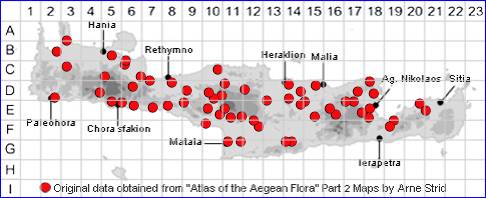
CYNOGLOSSUM COLUMNAE
Family:- BORAGINACEAE
Common Names:- None
Synonyms:- Mattia columnae, Rindera columnae.
Meaning:- Cynoglossum (Gr) Hound's-tongue, a name used by the Greek
physician Dioscorides' to describe the rough texture of the leaf.
Columnae (L) Named after the Italian botanist Fabio Colanna.
General description:- Fairly robust short to medium, softly hairy biennial
Stems:-
a) (15-)25-45(-60) cm.
b) angular, erect, branched above.
c) covered with stiff or coarse hairs (hirsute).
Leaves:-
1) Cauline;
a) oblong to lanceolate.
b) clasping the stem, but not completely encircling it (amplexicaul).
c) stalkless (sessile).
d) more or less covered with short, dense, matted hairs (tomentose) on both
surfaces.
Flowers:- Borne in a
1) Cymes:
a) branched flat-topped or convex bractless (ebracteate) flower clusters. which
elongate in fruit.
2) Calyx-lobes:
a) c. 5 mm.
b) ovate.
c) hirsute.
3) Corolla:
a) 5-6 mm.
b) purplish to deep blue.
d) tube, broadly cylindrical.
4) Stamens:
a) inserted in upper part of the tube.
Fruit:-
1) Nutlets:
a) 7-10 mm diam.
b) with a thickened edge giving a distinct border.
c) beset with barbed bristles (glochidia) on the disc, shorter than those on the
margin.
Key features:-
1) Cymes ebracteate (rarely bracteate at the base).
2) Nutlets 7-10 mm diam.
Habitat:- Rocky slopes with dry open shrubby vegetation. Open woodland and
meadows, mainly over limestone, 0-1500 m.
Distribution:- Fairly common throughout Greece except in most of the NE. - C & E
Mediterranean region from ltaly to W Anatolia. Widespread and common on Crete.
.
Flowering time:- Feb-June.
Photos by:- Steve Lenton
SPECIES DESCRIPTION
